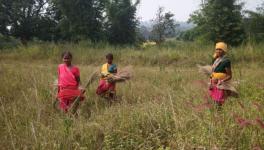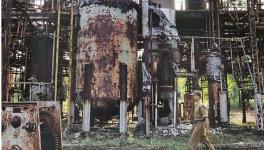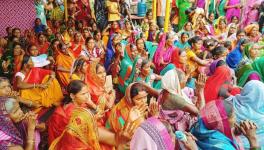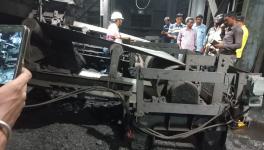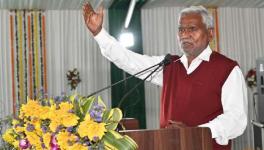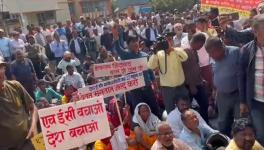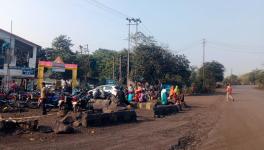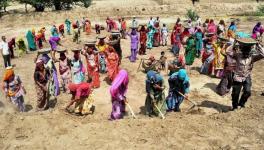Jharkhand: Behind India’s Nuclear Pride, Villagers Weep Radioactive Cries
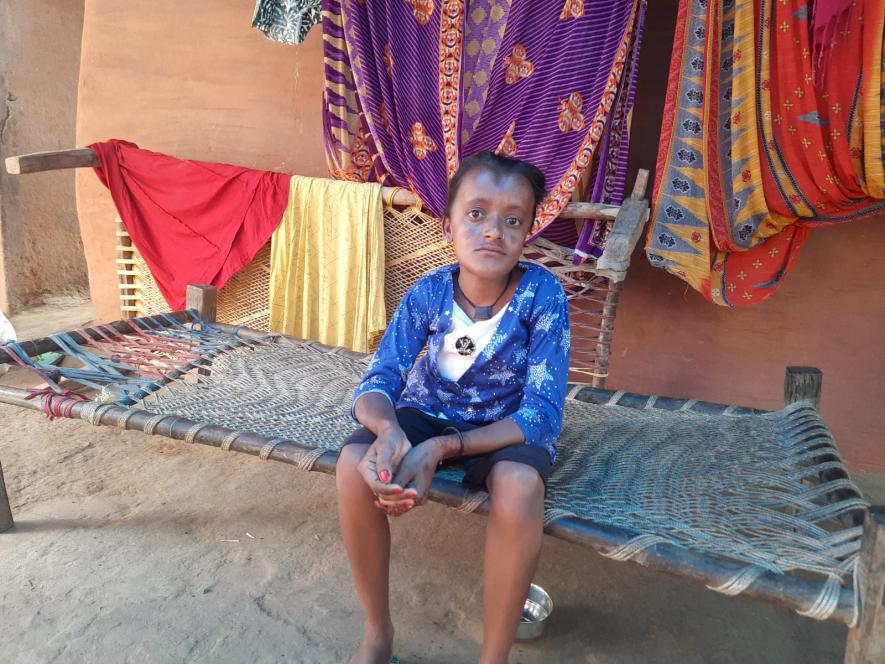
Sharvari says she is tired of talking to the people from the press and NGOs. None have helped her family's condition improve.
In the early 1900s, in a village in the East Singhbhum district of Jharkhand resided the adivasis, for whom farming and cattle rearing was the only occupation. Along the same time, in one particular route used by the villagers was a huge tree, and beside it, a small bridge-like structure.
After several incidents of miscarriage and many newborn kids having problems of disfiguration and disabilities, the villagers tended to believe that the tree was infested with ghosts. It became a common belief that whoever crossed the tree had to deal with these problems. Ever since, no pregnant woman was allowed to cross that tree, else the baby born was cursed. Several years passed by, and the villagers continued to be in despair until one day, a scientist came to Jadugoda and found the reason that busted these myths.
What the villagers thought to be a ‘ghost’ were radioactive traces, and hence, Uranium Corporation of India Ltd (UCIL) was formed. One of the only Uranium mining operations active in India currently, UCIL has been there since 1967. It was the first-ever uranium mine in the country. Uranium has several purposes; across the globe, it is used to power nuclear reactors that produce electricity, and its major use comes in the defence of a country. The path to make India a nuclear power was paved by these mines in Jadugoda in Jharkhand.
Once UCIL was formed, employees were hired to shift to Jadugoda. Slowly, a township took shape, and the first tailing pond was made to deposit the radioactive waste. Soon, to expand tailing ponds, UCIL acquired 50.23 acres of land, leaving scores of people homeless. Since then, 27 years have passed, and UCIL, in its notices, has claimed to be ‘committed to extending necessary support for rehabilitation.’
This was the first jolt that the 68 families living there faced, as still await the promised rehabilitation and the jobs promised to kids not 18 years old. Villagers claim that over 20 persons had gone missing immediately after being displaced. There were several conditions that the UCIL had agreed upon in a signed document of May 5, 1997. The document contained agreements for compensation of Rs 45,000 to each villager, a job to the then-able adults from each family, and a job to the kids when they turned 18, villagers told NewsClick.
The promises made about the jobs are allegedly yet to be fulfilled, and kids like Arjun(28) and Sunil(31) still await a job as promised by the company. As far as compensation for land is concerned, each family was promised 12 dismil of land. However, the total that they have lost is much more, they claim. In a few cases, 12 dismil won’t even cover the area where their houses were, let alone the farms they owned.
But the impact of the radiation was not just on their lives. The company with the creation of tailing ponds (the place where uranium waste is dumped) has left a long-standing impact on these villages where clear signs of people affected due to radiation can be seen. For every 1 kg of uranium extracted, radioactive waste of around 1,750 Kg is released. NewsClick visited four villages to assess the impact.
Near the beginning of Jadugoda is Chantikocha, where 68 families were first displaced. Today, the village has a dark aura. Many houses have been locked for years now, and there is little sign of animals that the cattle-rearing villagers used to rely upon, handpumps lie buried in knee-deep mud, showing signs of disuse.
As one enters the lane towards Chantikocha, it takes you to a ground on the left, 500m away from the tall boundary of the tailing pond. Young people can be seen playing cards on the ground, and some kids children wander around unaware of the air they are breathing.
“Many people have left the village after they realised the impact of the radiation. It is not safe to live here for a long time,” said Arjun Hembram, as he showed NewsClick some locked-up houses.
The impact of the radiation cannot be understood in a year or two. Its effect shows up only after a long time. As the years proceed, the radiation starts to impact the body. Its first immediate impact is in the form of skin diseases when white pores and spots start appearing. This is the most common disease in the village and was visible on villager’s skin in Chantikocha. When asked about the doctor’s response, some people said, “The doctor did not know what this was and said it would be alright in a while.”
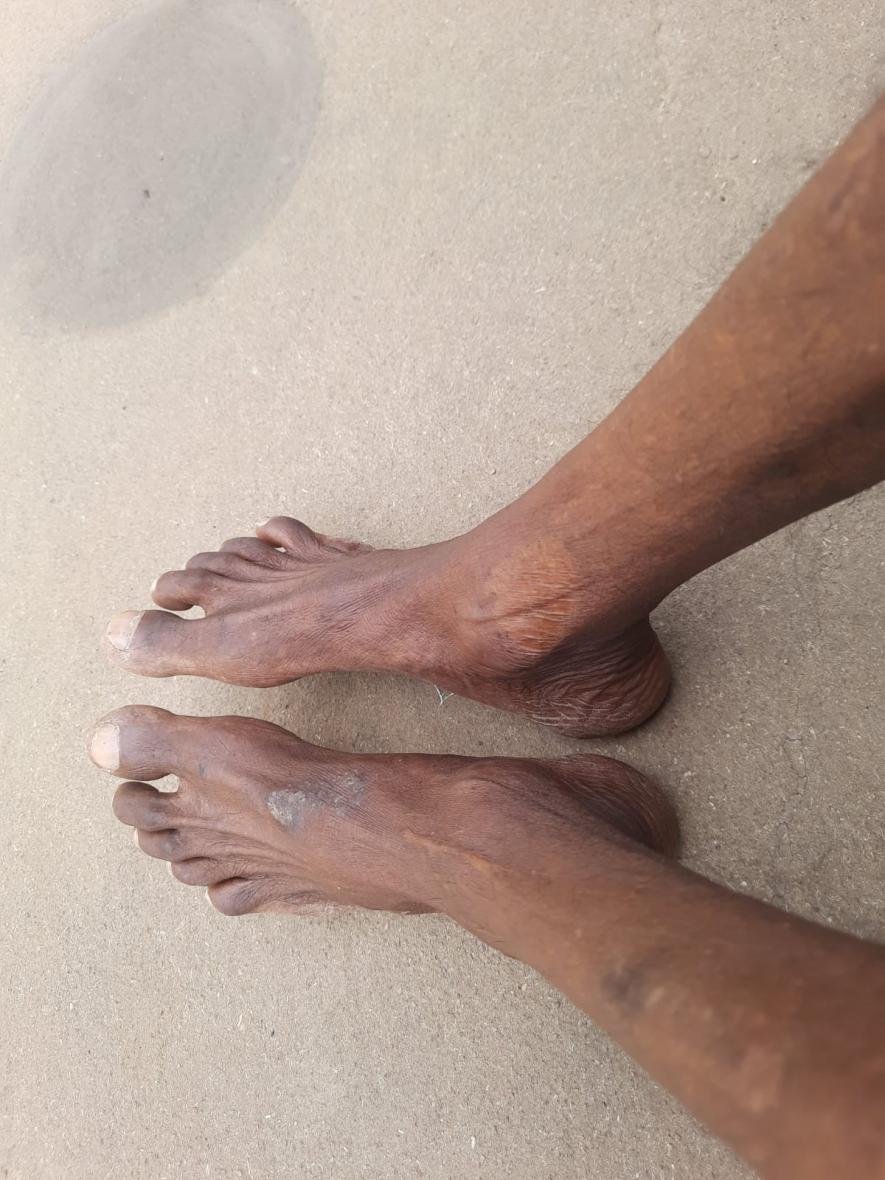
People in villages like Chantikocha and Bango have persistent skin problem
The more significant impact is on animals and land. The local pond that once was home to loads of fish the villagers would eat and sell, is now a dead pond that has turned completely green. Even animals refrain from drinking water from there. The pond is too close to the tailing pond.
“When we were young, we would take a bath here but we slowly realised that it was doing more harm to our bodies,” said Arjun. Around this pond was the land that used to be suitable for farming earlier. Now, there is nothing there except jungle grass, which has turned silver. This is one of the key emotional and financial cost the villagers faced have borne for uranium. They lost acres of their ancestral land that could be used for farming.
As the height of the tailing pond increased, so did seepage from its walls. The villagers gradually realised that the water in the pond was not good anymore.
“When we would go and take a bath there, the soap stopped producing foam, it turned oily. This was when we stopped using the pond water,” said a villager, Soon, the villagers found that their well water was going the same way and there was a change in its taste. Food started to take longer to cook with that water, and even after being cooked, it tasted weird, they said.
As the tailing pond expanded, more and more people started falling sick in the village, and the number of people dying young increased. Slowly, scores of people started to have skin diseases, heart and kidney problems. They said they stopped consuming the regular boring water via hand pumps and wells a couple of years ago but still live with the radioactive impact that has been left.
“In our village, most people do not die a natural death. Many keep falling sick throughout their lifetime. There is something for sure that is affecting us,” said an old lady, who is not literate but understands there is something wrong with the village.
The situation is worse for those who work in the tailing pond area or the mines. One such person is Gonda Banra, a contractual labourer, who works to prevent seepage at the ‘jehra sthal’ (worship spot) at the tailing pond. Banra, 28, looks older than his age, He says he is really scared to work there but has no option. The worship spot is such that it is surrounded by tailing ponds. In its corners lie the walls of the tailing pond that affects the place.
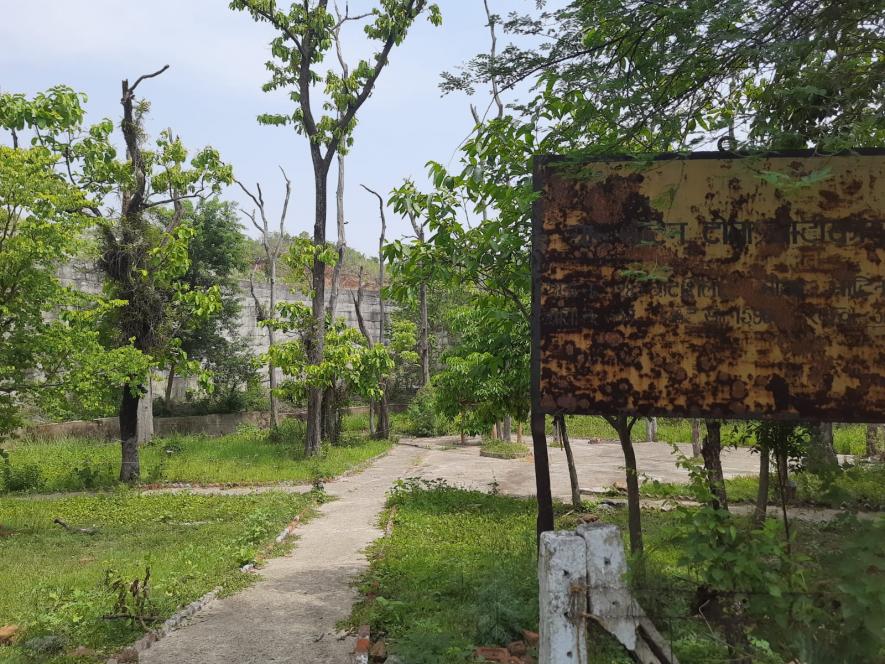
The worship spot for local adivasis who pray at the Sal tree between two tailing ponds where radioactive waste is dumped.
The tribal community here worships the Sal tree. Traditionally, the tribals keep visiting the area for special occasions, such as marriage. “During the rainy season, we come here a lot. We even cook and stay here. Imagine being surrounded by radioactive waste. We cannot go anywhere else. This is the only worship place we have,” Sunil, a villager, told NewsClick.
In the monsoon, radiation exposure is at its peak for villagers at the worship spot, right between the tailing pond. The walls of the tailing pond have cracks, and the same water seeps into the worship place. All the Sal trees in the area seem to be dead, with their trunks having turned grey.
While moving out of the tailing pond area, through the stones and barren land, this reporter saw long pipes carrying the waste and depositing it inside the pond. It was impossible to stand for long in the area where the opening was. The smell was too pungent, and the nose started burning. Villagers complain of rapid breathing and cough problems as well.
What was appalling was that right beside the place where the waste was dumped, some people from a nearby village were working on constructing a road. They did not have masks or any other source of protection. They were completely unaware of how perilous the grey water near them was. Some could also be seen passing by the ponds as if it was their regular route.
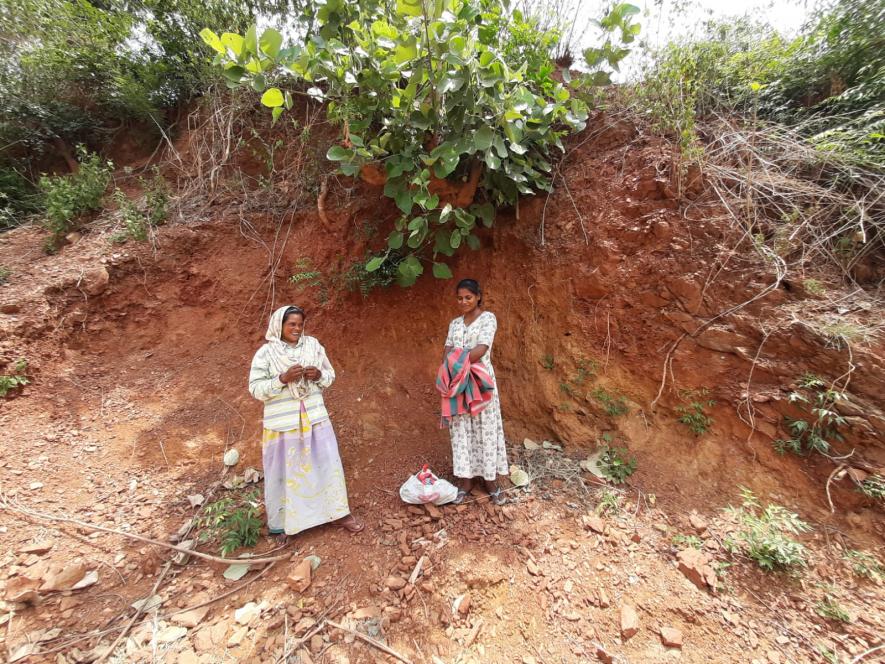
Road construction workers beside the tailing pond without any masks or safety gear.
Some of the remaining waste mixed up with water flowed down the lane along the main roads. If one followed the pipes, one could track where this radioactive waste was going. The channel travelled through the area into an open canal which further went through the sides of the main road. It reached a point where there were houses on both sides, and the canal flowed in-between.
Surprisingly, in every place the pipe went, the surroundings were covered with trees and shrubs, making it nearly impossible for passers-by to see. Further, it led to an opening into a significant water source for the steel city, the Subarnarekha river. What confirms the trace is that several research papers from professors of the Kolhan and universities in Bengal have shown in their research papers that Subarnarekha, in its several sites, shows radioactive traces.
Village after village from Chantikocha has suffered the hazardous impact of being close to the tailing pond. The farthest is a village called Bango. The ‘curse’ theory of the early 1900s has had the maximum impact here, and this is the village that still exhibits the results of uranium mining. In Bango, every third family that NewsClick met seemed impacted in some way or the other by radiation.
The people in this village say they are tired of giving interviews to reporters and NGO workers who come to them in search of stories. When NewsClick reached the Gope residence, Sharvari*, a disabled girl, was nowhere to be found. When this reporter asked her parents, they were annoyed and said she was not home. After a while, the child came out. She said she wanted to study more and wanted to make something out of herself. But neither her body nor her family's financial condition allowed her to do so. She has studied only until the 10th grade.
In the family, the second child had a face that was much larger than the body. The family said doctors had denied providing a disabled certificate to the child. Not only this, but even in Sharvari’s case, the family sometimes does not receive the pension granted for months, making it difficult to run the household. The only thing the family survives on is ‘sarkari ration’ and Sharvari’s pension under the Indira Gandhi National Disability Pension Scheme.
While Sharvari’s family is getting the pension, NewsClick met Rajesh Gope, a 14-year-old boy who has been declared 50% disabled. Despite the parents making rounds of the local authorities and the ward member, he does not get a pension. The family got his disability card made in 2022 and still awaits benefits of schemes under the Central and state government.
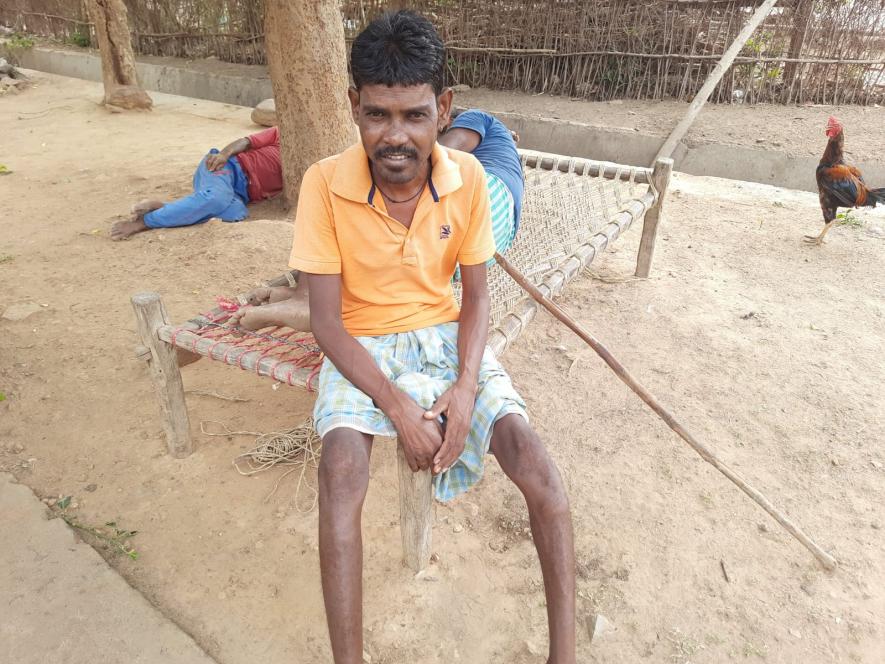
At the age of 35, the man from Bango was diagnosed with a disability in his leg and has been unable to work eversince.
Earlier, Gope used to go to school but now he cannot. Rajesh’s elder uncle is diabetic and has a certain problem with his speech and left arm. He cannot walk for long, and his whole body is getting weaker. His capacity to speak is also decreasing. Upon enquiring, it was found that Amrik, the elder uncle, used to go a lot in the tailing pond area when he was young to cut trees and make a living out of selling wood.
This is the story of almost everyone in Bango, although it is around 5 km away from the tailing pond area. Also, although the people say that the water available is
‘pure’, they still use groundwater for wells and tube wells. If the air distance between Bango and the nearest tailing pond were to be considered, it would be around 3 km only.
Moving further away from Bango, people in villages looked visibly healthy, and also practiced cattle rearing and farming. The groundwater there does not seem to be impacted as people use water from hand pumps.
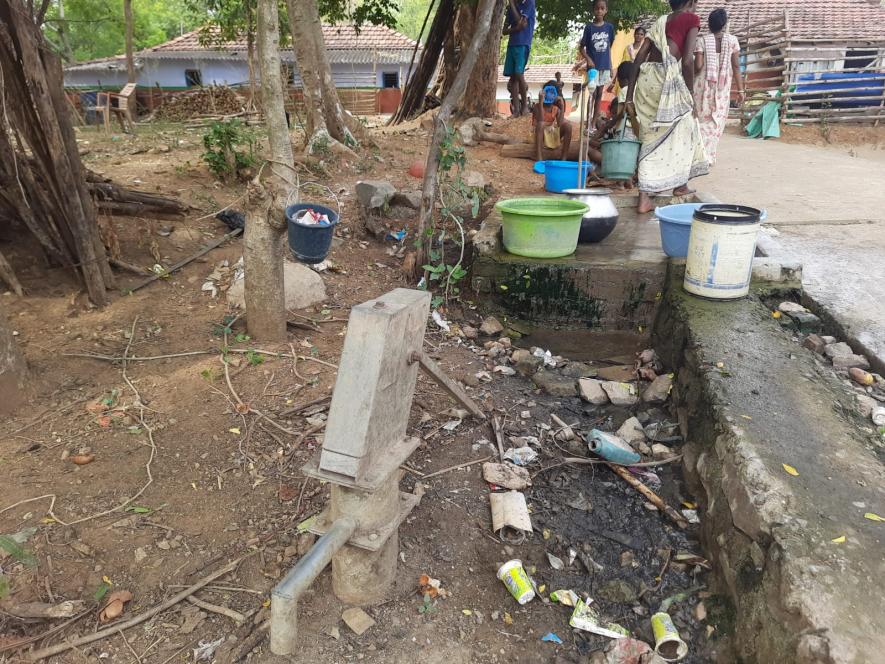
All hand pumps and wells in Chantikocha are buried deep in mud. The groundwater, the villagers say, is contaminated.
Over 700 meetings have already occurred between the displaced villagers' representatives, the government and UCIL authorities, said several villagers who have records of each meeting. They said they have been waiting for the next meeting to develop a concrete solution.
Meanwhile, UCIL continues to grow, just like any other private company. Though controlled by the Centre, it continues to be hijacked by private contractors, it is alleged. Unaware and helpless, the villagers continue to bear the brunt of the radioactive plant and its deposited waste.
This reporter made multiple attempts to reach out to UCIL for a response to the allegations made by the villagers and, as assessed by NewsClick, but received no reply. The story will be updated as and when UCIL responds.
Get the latest reports & analysis with people's perspective on Protests, movements & deep analytical videos, discussions of the current affairs in your Telegram app. Subscribe to NewsClick's Telegram channel & get Real-Time updates on stories, as they get published on our website.









